Fungi associated with seeds of huckleberry (Solanum scabrum Mill.) grown in the western highlands of Cameroon
Main Article Content
Abstract
Article Details

This work is licensed under a Creative Commons Attribution-NonCommercial-NoDerivatives 4.0 International License.
References
Akter, N. (2008). Effect of plant extract on the management of seed borne fungal diseases of okra. (Master’s thesis). Department of Plant Pathology, BAU, Mymensingh. pp. 36-74.
Alam, M. M. (2002). Studies on the health of some vegetable seeds collected from different sources. (Master’s thesis). Department of Plant Pathology, Bangladesh Agricultural University, Mymensingh. 49 pp.
AlKassim, M. Y. (1996). Seed-borne fungi of some vegetables in Saudi Arabia and their chemical control. Arab Gulf Journal of Scientific Research 14:705-715.
Begum, N. (2012). Assessment of health and quality of some vegetables seeds of Saidpur. (Master’s thesis). Department of plant pathology, BAU, Mymensingh. 36 pp.
Bolkan, H. A., Silva, A. R. and Cupertino, F. P. (1976). Fungi associated with soybean and bean seeds and their control in Central Brazil. Plant Disease Reporter. pp. 545-548.
Champion, R. (1997). Identifier les champignons transmis par les semences. Paris, France: Institut National de la Recherche Agronomique. 401 pp.
Chowdhury, Z., Monjil, M. S., Chowdhury, M. F. I. and Hossain, M. M. (2005). Seed borne fungi in Cucumber (Cucumis sativa L.) and musk-melon (Cucumis melo L.) of Mymensingh, Bangladesh. Journal of Seed Science and Technology 9:105-109.
Dupriez, H. and De Leener, P. (1989). African gardens and orchards growing vegetables and fruits. London, United Kingdom: Mac Milan Press. 333 pp.
Edmonds, J. M. and Chewya, J. A. (1997). Black nightshades: Solanum nigrum L. and related species. Rome: International Plant Genetic Resources Institute (IPGRI).
Elarosi, H. (1993). Diseases of vegetables. Alexandria: New Publishing House. 310 pp.
Fontem, D. A., Songgwalang, A. T., Berinyuy, J. E. and Schippers, R. R. (2003). Impact of fungicide application for late blight management on huckleberry yields in Cameroon. African Crop Science Journal 11:163-170.
Goldberg, N. P. (2011). Chile pepper diseases. Circular. 549 Consumer and Environmental Sciences, New Mexico State University.
Gupta, K., Sindu, I. R. and Nazz, S. (1989). Seed mycoflora of Abelmoschus esculentus (L.) Moench: A Survey and enumeration. Journal of Acta Botanica Indica 17:200-206.
Hamim, D. C., Mohanto, M. A., Sarker, R. and Ali, M. A. (2014). Effect of seed borne pathogens on germination of some vegetable seeds. Journal of Phytopathology and Pest Management. pp. 34-51.
Islam, M. S. (2006). Study on the seed health status of selected vegetable crops. (Master’s Thesis). Department of Plant Pathology, Bangladesh Agricultural University, Mymensingh, 47 pp.
ISTA. (2001). International rules for seed testing, rules amendments. Journal of Seed Science and Technology 29:1-12.
Jamadar, M. M., Ashok, S., Shamrao, J., Sajjan, A. and Jahangidar, S. (2001). Studies on seed mycoflora and their effect on germination of colour graded Okra (Abelmoschus esculentus (L.) Moench). Journal of Crop Research 22:479-484.
Kamble, P., Borkar, G. M. and Patil, D. V. (1999). Studies on seed borne pathogens of pumpkin, cucumber, watermelon and muskmelon. Journal of Soils and Crops 9:234-238.
Khan, S. N. (2007). Macrophomina phaseolina as causal agent for charcoal rot of sunflower. Mycopath 5:111-118.
Khanom, D. (2011). Assessment of health and quality of some vegetables seeds of Mymensingh. (Master’s thesis). Department of plant pathology, BAU, Mymensingh, 28 pp.
Kokwara, J. O. (1976). Medicinal plants of East Africa. Nairobi: East Africa Literature Bureau, 225 pp.
Komolafe, M. F., Adegbola, A. A., Are, L. H. and Ashaye, T. I. (1980). Agricultural science for West African schools and colleges 2nd edition. Oxford University Press: Ibadan, pp. 191-196.
Mathur, S. B. and Olga, K. (2003). Common laboratory seed health testing methods for detecting Funfi. Copenhagen, Denmark: DK-1871 Frederiksberg C, 425 pp.
Mathur, S. K., Mathur, S. B. and Neergaard, P. (1975). Detection of seed-borne fungi in Sorghum and location of Fusarium moniliforme in the seed. Seed Science and Technology 3:683-690.
Mbong, A. M. A., Djiokeng, P. G., Ntentie, F. R., Dimodi, H., Ngondi, J. L. and Oben, E. J. (2014). Protective effect of Hydroethanolic extracts of Solanum scabrum and Cola verticillata against Cyclophosphamide induced toxicity in female rats. Journal of Food Research 3.
Ngundam, C. F. P. (1997). The place of indigenous vegetables in the farming system of Cameroon. In: African indigenous vegetables. In Schippers, R. R. and Budds, L. (Eds.), Workshop proceedings. ODA, UK.: Limbe, Cameroon. pp. 52-57.
Nowicki, M., Nowakowska, M., Niezgoda, A. and Kozik, E. (2012). Alternaria black spot of crucifers: symptoms, importance of disease, and perspectives of resistance breeding. Vegetable Crops Research Bulletin 76:5-19.
Otani, H., Kohmoto, K. and Kodama, M. (1995). Alternaria toxins and their effects on host plants. Canadian Journal of Botany 73:453458.
Puspa, K., Borkar, G. M. and Patil, D. V. (1999). Studies on seed borne pathogens of pumpkin, cucumber, watermelon and muskmelon. Journal of Soils and Crops 9:234-238.
Richardson, M. J. (1990). An annotated list of seed borne diseases 4th edition. Switzerland: The International Seed Testing Association. 338 pp.
Schippers, R. R. (2000). African indigenous vegetables. An over view of the cultivated species. Chathan, UK; Natural Resources Institute /ACP – EU. Technical center for Agricultural and Rural cooperation.
Schippers, R. (1998). Notes on Huckleberry, Solanum scabrum and related black nightshade species. National Ressources Institute, 17 pp.
Sultana, L. (2009). Assessment of health status of TLS of bean, tomato, okra and cowpea seeds in the markets of Bangladesh. (Master’s thesis). Department of Plant Pathology, BAU, Mymensingh. 39 pp.
Tsopmbeng, N. G. R. (1994). Seed-borne fungi in African Yam bean (Sphenostylis stenocarpa Horchst ex. A. Rich Harms) and their responses to fungicidal seed-treatment. (Master’s thesis). University of Nigeria Nsukka, Nigeria. 100 pp.


